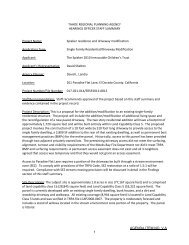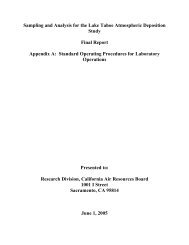FEIS - Tahoe Regional Planning Agency
FEIS - Tahoe Regional Planning Agency
FEIS - Tahoe Regional Planning Agency
You also want an ePaper? Increase the reach of your titles
YUMPU automatically turns print PDFs into web optimized ePapers that Google loves.
RESPONSE TO COMMENTS ON THE DEIS<br />
B o u l d e r B a y C o m m u n i t y E n h a n c e m e n t P r o g r a m P r o j e c t E I S<br />
be installed as part of the Project; therefore, they were not included in the analysis of<br />
stationary source emissions. Project related stationary source emissions will comply<br />
with the TRPA Code of Ordinances Chapter 91.3 for Combustion Appliances,<br />
including natural gas fired water heaters and central furnaces). The overall emissions<br />
summary (results from Urbemis) for both stationary and mobile emissions sources is<br />
provided in Tables 4.9-8 and 4.9-9 of the DEIS. Roadway snowmelt systems require<br />
a boiler to operate. The addition of additional boiler capacity for operation of the<br />
roadway snowmelt system would not substantially change the conclusions of the<br />
Urbemis analysis for Alternatives C and D since the majority of the emissions are<br />
generated by vehicle trips, which decline under these Alternatives. It should also be<br />
noted that the operation of the snowmelt system replaces other traditional means for<br />
snow removal, including snow plows, deicers, etc. As shown in the Chapter 4.9<br />
Tables, Alternative C would not exceed any of the emission standards of the TRPA.<br />
However Boulder Bay has commissioned an analysis for the snowmelt system which<br />
will be available for review by decision makers during the project hearings.<br />
Comment 93-v: Comment Summary - NOISE-1: Alt. C - where is the analysis?<br />
The analysis is contained within Tables 4.10-8 and 4.10-9. The Federal Highway<br />
Administration (FHWA RD77-108) traffic noise prediction model was used to<br />
evaluate the Alternative C traffic noise impacts. Direct inputs to the model were<br />
based upon traffic volumes provided by the project traffic consultant. Mitigation<br />
measures are based upon research conducted for Alternative Pavements.<br />
Comment 93-w: Comment Summary - NOISE-3: Alt. C - where is the analysis?<br />
The construction noise control program prepared for Boulder Bay by SMC<br />
Contracting, Inc. (see Chapter 2.5) proposes construction activities outside of the<br />
exempt hours of operation contained within the TRPA noise ordinance. Construction<br />
noise levels outside of the exempt hours that exceed Plan Area CNEL standards will<br />
result in significant noise impacts.<br />
During the construction phases of the Project, noise from construction activities will<br />
add to the noise environment in the immediate project vicinity. Activities involved in<br />
construction will generate maximum noise levels, as indicated in Table 4.10-16,<br />
ranging from 76 to 95 dB at distances of 50 to 100 feet. Construction activities will<br />
be temporary in nature and are anticipated to occur during normal daytime working<br />
hours.<br />
Noise will also be generated during the construction phase by increased truck traffic<br />
on area roadways. A significant project-generated noise source will be truck traffic<br />
associated with transport of heavy materials and equipment to and from construction<br />
sites. This noise increase will be of short duration, and will likely occur primarily<br />
during daytime hours. Based on predicted construction related noise levels, this<br />
impact is considered to be significant.<br />
Mitigation is based upon restricting the hours of operation within the TRPA noise<br />
ordinance hours of operation, unless the TRPA finds that some construction<br />
activities, such as concrete pours can occur between 6:30 p.m. and 8:00 a.m. qualifies<br />
as “emergency work” to minimize traffic impacts. In addition, shielding of<br />
equipment and appointing a noise complaint coordinator on the site were included to<br />
minimize the noise levels.<br />
Comment 93-x: Comment Summary - NOISE-C1: Where is the analysis? Five years of construction<br />
is more than temporary noise.<br />
PAGE 8- 36 HAUGE BRUECK ASSOCIATES SEPTEMBER 8 , 2010






